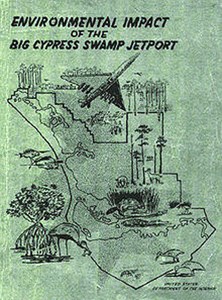
Spurred by increasing growth and the rapidly expanding population of South Florida in the 1960s, the state wanted to build a jetport that would support the growing community through futuristic aspirations of aircraft capable of carrying up to 1,000 passengers each, and capable of flying coast-to-coast in supersonic time. However, aeronautical engineers understood that aircraft breaking the sound barrier over populated areas would not be tolerated, although supersonic airliners were considered the way of the future. As a result, Dade County Port Authority purchased 39 square miles of remote swamp land 48 miles away from Marco Island (and just six miles north of the Everglades National Park boundary). As work began in 1968, the ambitious Everglades Jetport was intended to have six runways. There would also be a 1,000-foot-wide corridor linking the airport to both coasts consisting of a new interstate highway and monorail high-speed mass transit system. Five times larger than JFK International Airport, it was to be the largest airport in the world. 
To research potential impacts of the jetport, Russell E. Train, then undersecretary of the Department of the Interior, tasked Dr. Luna B Leopold, senior research hydrologist and former head of the water resources division for the United States Geological Survey with the job. Son of renowned author and wildlife conservationist Aldo Leopold, Dr. Luna Leopold voiced strong opposition to the jetport. He, Arthur Marshall, a scientist and everglades conservationist, and Manuel Morris of the National Park Service collaborated on the Environmental Impact Report of the Big Cypress Swamp Jetport. This report is considered the first ever environmental impact study for the state of Florida.

When the report was released in 1969, the report began by stating: "Development of the proposed jetport and its attendant facilities will lead to land drainage and development for agriculture, transportation, and services in the Big Cypress Swamp which will inexorably destroy the south Florida ecosystem and thus the Everglades National Park." Alarmed by what the research suggested and the threat to an end of their traditional way of life, a coalition of hunters, conservationists and citizen activists, including, Marjory Stoneman Douglas, and the newly formed Friends of the Everglades, pressured the port authority to find another location for the jetport. The coalition was aided in no small part by Dr Luna Leopold's environmental impact study. In 1970, work on the jetport was halted through the Everglades Jetport Pact, which resulted in the port authority immediately instituting measures to search for another jetport location. 
Today, located along the eastern boundary of Big Cypress National Preserve, the 24,960 acre Dade-Collier Training and Transition Airport (also known as TNT) consists of only one runway, and is used as an aviation training facility. Encompassing it, is Big Cypress National Preserve. It was established on October 11, 1974, by President Gerald Ford, as the nation's first national preserve, set aside to:
|
Last updated: May 1, 2020
